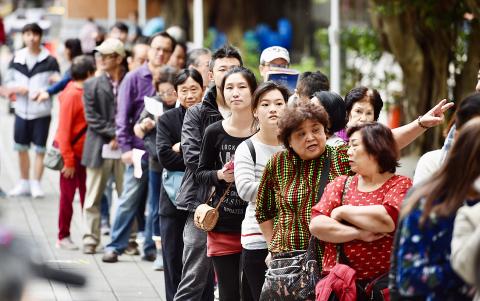Taiwanese voted in 10 referendums alongside yesterday’s nine-in-one local elections — the greatest number of referendums held simultaneously since the plebiscite mechanism was implemented in 2004.
The referendums covered a broad range of issues, including the definition of marriage in the Civil Code, the ban on food imports from five Japanese prefectures imposed after the Fukushima Dai-ichi nuclear power plant disaster in 2011 and changing the national team’s name from “Chinese Taipei” to “Taiwan” for the 2020 Tokyo Olympic Games.
A total of 19,757,067 people were eligible to vote on yesterday’s referendums, the Central Election Commission (CEC) said.

Photo: Liao Chen-huei, Taipei Times
Amendments to the Referendum Act (公民投票法) in December last year lowered the threshold needed to pass a referendum.
Yesterday, at least one-quarter of the eligible voters — or 4,939,267 votes — needed to be in favor of a referendum, with the “yes” votes outnumbering the “no” votes, for a referendum to pass.
Results of the 10 referendums were not available at press time last night.
The CEC on Friday said it hoped to finish counting all the referendum ballots by midnight yesterday, meaning that the results could be announced by 2am today.
By law, referendum results must be made public within seven days, CEC Vice Chairman Chen Chao-chien (陳朝建) said.
Under the Referendum Act, a law repealed in a referendum would be rescinded three days after the result is officially announced by the commission, Chen said.
A result that calls for new legislation would require the government to submit a proposed bill no later than three months after the vote and the Legislative Yuan to complete a review before the next summer or winter break, the act says.
A result that calls for a change in policy would require the president or relevant authority to take steps to implement the change, the act says.
The referendum sponsor can apply to the Council of Grand Justices for an interpretation if they feel that the authorities have not handled the matter properly, Chen added.
A referendum that does not pass is not legally binding and no referendum can be launched on the same topic for two years, Chen said.
Prior to yesterday’s vote, the CEC made public the Executive Yuan’s opinions regarding the 10 referendums.
The Executive Yuan maintains that if the referendum passes, the government should respect the results calling for the name of the national team participating in the 2020 Tokyo Olympic Games to be changed from “Chinese Taipei” to “Taiwan.”
If the referendum passes, the Chinese Taipei Olympic Committee would be tasked with filing applications with the International Olympic Committee, moving forward on the assumption that the nation’s Olympic membership remains valid and that Taiwanese athletes can still represent Taiwan at the Games, the Executive Yuan said.
The Executive Yuan maintains that enough thermal power plants would need to remain operational to ensure stable power output even if the referendum proposed by Chinese Nationalist Party (KMT) Legislator Lu Shiow-yen (盧秀燕) passed.
It called for power output from thermal power plants be lowered by 1 percent annually.

‘WIN-WIN’: The Philippines, and central and eastern European countries are important potential drone cooperation partners, Minister of Foreign Affairs Lin Chia-lung said Minister of Foreign Affairs Lin Chia-lung (林佳龍) in an interview published yesterday confirmed that there are joint ventures between Taiwan and Poland in the drone industry. Lin made the remark in an exclusive interview with the Chinese-language Liberty Times (the Taipei Times’ sister paper). The government-backed Taiwan Excellence Drone International Business Opportunities Alliance and the Polish Chamber of Unmanned Systems on Wednesday last week signed a memorandum of understanding in Poland to develop a “non-China” supply chain for drones and work together on key technologies. Asked if Taiwan prioritized Poland among central and eastern European countries in drone collaboration, Lin

The Chien Feng IV (勁蜂, Mighty Hornet) loitering munition is on track to enter flight tests next month in connection with potential adoption by Taiwanese and US armed forces, a government source said yesterday. The kamikaze drone, which boasts a range of 1,000km, debuted at the Taipei Aerospace and Defense Technology Exhibition in September, the official said on condition of anonymity. The Chungshan Institute of Science and Technology and US-based Kratos Defense jointly developed the platform by leveraging the engine and airframe of the latter’s MQM-178 Firejet target drone, they said. The uncrewed aerial vehicle is designed to utilize an artificial intelligence computer

Renewed border fighting between Thailand and Cambodia showed no signs of abating yesterday, leaving hundreds of thousands of displaced people in both countries living in strained conditions as more flooded into temporary shelters. Reporters on the Thai side of the border heard sounds of outgoing, indirect fire yesterday. About 400,000 people have been evacuated from affected areas in Thailand and about 700 schools closed while fighting was ongoing in four border provinces, said Thai Rear Admiral Surasant Kongsiri, a spokesman for the military. Cambodia evacuated more than 127,000 villagers and closed hundreds of schools, the Thai Ministry of Defense said. Thailand’s military announced that

CABINET APPROVAL: People seeking assisted reproduction must be assessed to determine whether they would be adequate parents, the planned changes say Proposed amendments to the Assisted Reproduction Act (人工生殖法) advanced yesterday by the Executive Yuan would grant married lesbian couples and single women access to legal assisted reproductive services. The proposed revisions are “based on the fundamental principle of respecting women’s reproductive autonomy,” Cabinet spokesperson Michelle Lee (李慧芝) quoted Vice Premier Cheng Li-chiun (鄭麗君), who presided over a Cabinet meeting earlier yesterday, as saying at the briefing. The draft amendment would be submitted to the legislature for review. The Ministry of Health and Welfare, which proposed the amendments, said that experts on children’s rights, gender equality, law and medicine attended cross-disciplinary meetings, adding that